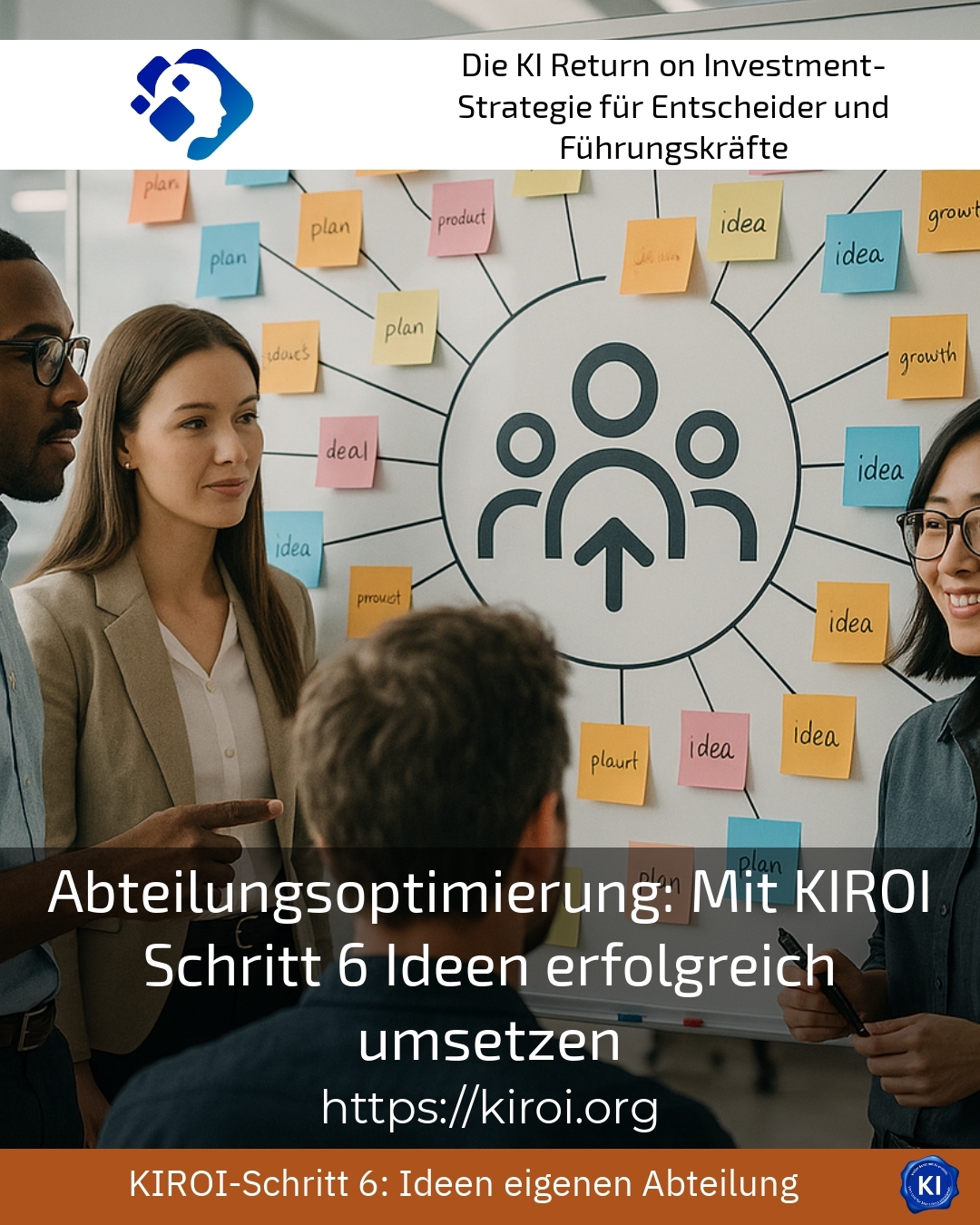Departmental optimisation is a key success factor for modern companies. This is not just about structural changes, but above all about successfully implementing ideas within the departments using suitable methods and targeted impulses. In particular, the integration of innovative technologies, as envisaged by the KIROI strategy for example, can provide support. Step 6 of this strategy focuses specifically on how creative approaches are systematically developed and implemented in order to achieve measurable results.
Why departmental optimisation through innovative ideas is important
Companies often report that finding and implementing new ideas within their own department is a major challenge. Departmental optimisation aims to support precisely this innovative spirit and at the same time make day-to-day work more efficient. In sales, for example, simple automation of recurring reporting tasks can help to free up more time for customer care. Similarly, in the IT department, the targeted use of AI-supported tools can speed up error analyses. And in marketing, AI-based campaign optimisation can be used to reach significantly better target groups, which ultimately has a positive impact on departmental results.
Department optimisation with KIROI Step 6: Develop and implement ideas
The sixth step of the KIROI strategy focuses on the implementation of specific projects developed within the department. This phase is crucial because it is here that the theoretical approaches are transformed into practice. Many companies are faced with the challenge of organising innovative ideas in such a way that they do not disrupt ongoing operations and are also quickly effective.
In the HR department of a medium-sized company, for example, KIROI Step 6 was used to introduce a digital tool for applicant management. This simplified the entire process from advertisement to recruitment and significantly reduced sources of error. In customer service, AI-controlled chatbots enabled faster responses to frequent enquiries, which improved customer satisfaction. At the same time, logistics optimised delivery times through automated route planning and saved considerable costs.
BEST PRACTICE with one customer (name hidden due to NDA contract) A structured process for developing prototypes was implemented within the IT department with KIROI step 6. The team worked together on an interdisciplinary basis and integrated digital collaboration tools. This led to several tested innovations that noticeably accelerated the workflow and reduced sources of error.
Practical tips for successful department optimisation
For the successful implementation of optimisation approaches, it is advisable to combine different methods. For example, a continuous improvement process (CIP) can be used to work on processes in a step-by-step and team-orientated manner. It is important that employees are actively involved and motivated to contribute their perspectives. Regular workshops can also provide new impetus. In addition, the use of tools such as the Ishikawa diagram helps to precisely analyse the causes of bottlenecks.
Let's take a look at production management: CIP workshops enabled teams to recognise bottlenecks in the provision of materials more quickly and introduce improvements. In sales, on the other hand, targeted feedback rounds served as a discussion platform for new approaches to preparing quotations. And in accounting, a digital workflow made processing easier by significantly reducing errors caused by manual entries.
How KIROI Step 6 works as an accompaniment
Transformation coaching, as provided for in KIROI Step 6, accompanies projects relating to departmental optimisation. This involves analysing processes, promoting ideas and at the same time overseeing their implementation. The coaching helps to ensure that innovative impulses do not just arise sporadically, but are continuously optimised in a sustainable cycle. This creates a corporate culture that promotes both creativity and efficiency.
An example from the customer advisory service shows how a structured coaching approach supported the transition to digital advisory tools. Employees received targeted training and were able to clarify questions in a joint dialogue. Another example is the development of new product ideas in research, which were advanced in a targeted manner through regular status meetings and feedback loops. Finally, the introduction of flexible shift planning in production facilitated acceptance among employees through coaching.
My analysis
Departmental optimisation is an ongoing process in which the development and implementation of new ideas plays a decisive role. The KIROI strategy, especially step 6, provides practical impulses that help to implement projects efficiently. Companies benefit by organising processes more efficiently, strengthening their innovative power and at the same time better integrating employees. The combination of a methodical approach, the use of technology and coaching provides useful support for these change processes. In this way, departmental optimisation can be seen as a sustainable approach that addresses modern requirements and supports competitiveness.
Further links from the text above:
Step 6 of the KIROI strategy: Practical examples for your own department [2]
Department idea optimisation: With KIROI step 6 to success [4]
AI as an opportunity in times of skills shortages [6]
For more information and if you have any questions, please contact Contact us or read more blog posts on the topic Artificial intelligence here.















